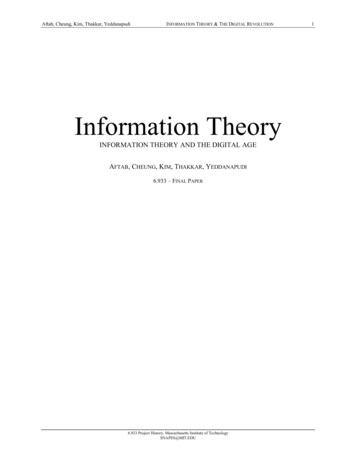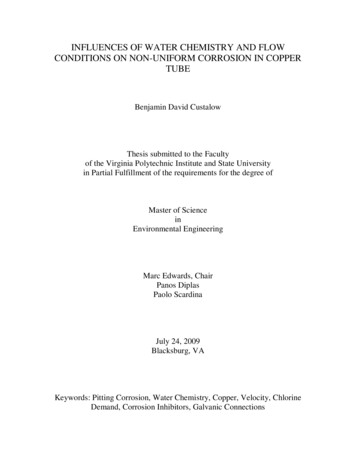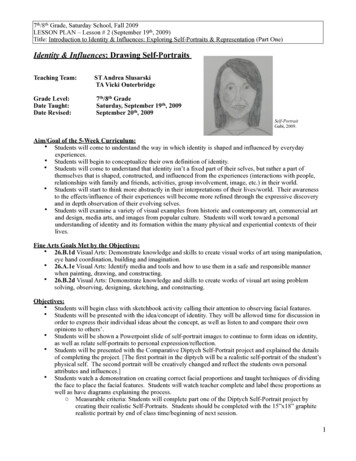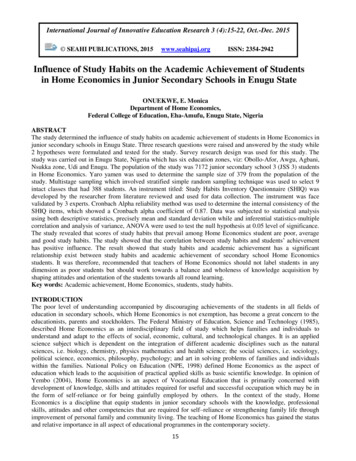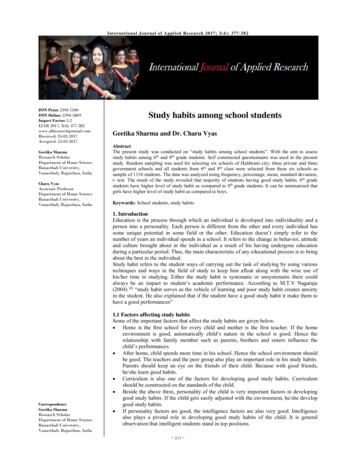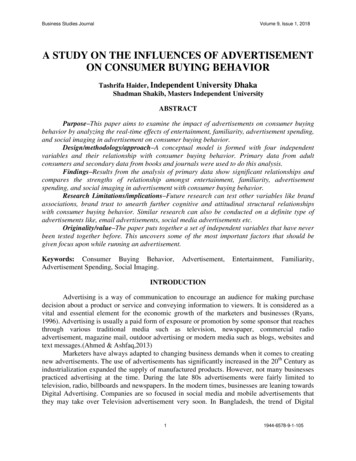
Transcription
Business Studies JournalVolume 9, Issue 1, 2018A STUDY ON THE INFLUENCES OF ADVERTISEMENTON CONSUMER BUYING BEHAVIORTashrifa Haider, Independent University DhakaShadman Shakib, Masters Independent UniversityABSTRACTPurpose–This paper aims to examine the impact of advertisements on consumer buyingbehavior by analyzing the real-time effects of entertainment, familiarity, advertisement spending,and social imaging in advertisement on consumer buying behavior.Design/methodology/approach–A conceptual model is formed with four independentvariables and their relationship with consumer buying behavior. Primary data from adultconsumers and secondary data from books and journals were used to do this analysis.Findings–Results from the analysis of primary data show significant relationships andcompares the strengths of relationship amongst entertainment, familiarity, advertisementspending, and social imaging in advertisement with consumer buying behavior.Research Limitations/implications–Future research can test other variables like brandassociations, brand trust to unearth further cognitive and attitudinal structural relationshipswith consumer buying behavior. Similar research can also be conducted on a definite type ofadvertisements like, email advertisements, social media advertisements etc.Originality/value–The paper puts together a set of independent variables that have neverbeen tested together before. This uncovers some of the most important factors that should begiven focus upon while running an advertisement.Keywords: Consumer Buying Behavior,Advertisement Spending, Social TRODUCTIONAdvertising is a way of communication to encourage an audience for making purchasedecision about a product or service and conveying information to viewers. It is considered as avital and essential element for the economic growth of the marketers and businesses (Ryans,1996). Advertising is usually a paid form of exposure or promotion by some sponsor that reachesthrough various traditional media such as television, newspaper, commercial radioadvertisement, magazine mail, outdoor advertising or modern media such as blogs, websites andtext messages.(Ahmed & Ashfaq,2013)Marketers have always adapted to changing business demands when it comes to creatingnew advertisements. The use of advertisements has significantly increased in the 20th Century asindustrialization expanded the supply of manufactured products. However, not many businessespracticed advertising at the time. During the late 80s advertisements were fairly limited totelevision, radio, billboards and newspapers. In the modern times, businesses are leaning towardsDigital Advertising. Companies are so focused in social media and mobile advertisements thatthey may take over Television advertisement very soon. In Bangladesh, the trend of Digital11944-6578-9-1-105
Business Studies JournalVolume 9, Issue 1, 2018Marketing is just on the bloom. Most large local and multinational giant companies are nowpracticing digital marketing in full swing.The major aim of advertising is to impact on buying behavior; however, this impact aboutbrand is changed or strengthened frequently through people’s memories. Memories about thebrand are formed by associations that are related to brand name in consumer mind.(Khan Niazi& Hunjra, (2012)).These brands continuously influence consideration, evaluation, and finallypurchases (Romaniuk & Sharp, 2004).Consumers buying behavior has always been given somuch importance and space in the literature study of impact of advertising regarding itseffectiveness (Ajzen, 2002). Most of the time consumers buying behavior depends on liking ordisliking of consumer towards the advertisement of the product advertised (Smith, Medin &Smith, 2006). A good quality advertisement is likely to influence consumers into buying thatproduct while a poor quality advertisement will do the opposite.Previous studies have been conducted on effectiveness of advertisement and onadvertisement’s impact on consumer buying behavior which depicted positive relationships.However, in this paper we have introduced a combination of different variables and attempted toexamine their influence on consumer behavior. This paper aims to determine which of thesevariables carries the most importance in terms of effecting consumer behavior and which of thesevariables carries less significant impact. This will help marketers to focus on the right factors andachieve maximum benefit from their advertisement.We believe that the study will offer useful insights for both advertising scholars andexecutives to understand the ins and outs of advertising and to assist marketers in introducingbetter approaches to advertising.BACKGROUND OF THE STUDYFollowing are the review of major research work on the topic which is related to the presentstudy.Prateek Maheshwari, Nitin Seth & Anoop Kumar Gupta (2016) in their article “Anempirical approach to consumer buying behavior in Indian automobile sector" have concludedthat advertisement effectiveness positively influences consumer buying behavior. (Maheshwari,Seth & Gupta, AK 2016)Hong-Youl, Ha Joby, John Swinder & Janda Siva Muthaly (2011). In their research paper"The effects of advertising spending on brand loyalty in services" have discovered thatadvertising spending has impact on consumer’s perceived quality of the product, consumer’sloyalty and satisfaction level. (Ha YH, John, Janda & Muthaly, 2011).Dr. D. Prasanna Kumar & K. VenkateswaraRaju (2013). In their paper “The Role ofAdvertising in Consumer Decision Making” have found that advertisements are able to changethe consumer’s opinion about a particular product. (Kumar & Raju, 2013).Advertising has always known to be one of the key factors that affect consumer’sdecision making process. In this paper, we have attempted to combine different sets of variablesfrom these previous studies to test and analyze how they impact consumer’s buying intention.21944-6578-9-1-105
Business Studies JournalVolume 9, Issue 1, 2018REVIEW OF LITERATUREEntertainmentEntertainment has been one of the primary criteria for creating an advertisement.Entertainment is used as a tool to gain attention of customers. An interesting and entertaining adis more likely to be remembered by consumers rather than a boring one. Therefore, it can be saidthat entertainment increases the effectiveness of advertising. That is why many companies areinvesting a lot of money to make advertisements that are humorous. (Mandan, Hossein &Furuzandeh)Former studies suggest that entertainment in advertising generates customer satisfaction(Chag, 2006). This claim was tested by later empirical studies. For instance, Duncan and Nelson(1985) conducted a research on how entertainment in advertisement affects consumers. Theyanalyzed 157 responses towards advertising and found that entertaining advertisements caninfluence consumers. It influences consumers into accepting and consuming the product.(Duncan & Nelson, 1985). In a similar way, Chang (2006) investigated about entertainingadvertisements and its influence on consumer satisfaction and leave impact on their behavioralintentions. Based on his research on 152 participants, he found that entertaining advertising canpositively increase consumers’ satisfaction, thus influencing consumer buying behavior.(chang,2006)Although use of humor in advertisements can be risky at times as a large number ofpeople may not be entertained by the same concept. Gulas and Weinberger in their book say thata failed attempt to entertaining ads is a lost opportunity to connect with consumers. It may evenoffend consumers and drive them away. They have exemplified this risk with a 1999 Super Bowladvertisement for ‘Just for Feet’. It showed a group of white men tracking a barefoot, blackKenyan runner who was later drugged and forced against his will to wear a pair of running shoes.The advertisement was met with massive outrage.(Gulas & Weinberg, 2006).However, entertaining advertisements do not necessarily mean humorous ads. Thrilling,full of suspense advertisements can also be counted as entertaining. One of the biggest examplesof all time is the Apple super bowl commercial “1984”. It left people awestruck and it wasimmediately able to get attention of people. It was very effective in terms of spreading newsabout a new era of computers. It also had a huge part in generating sales for the company.Harvard professor Thales Teixeira has conducted an interesting study on this regard andwrote a paper “Why, When, and How much to entertain consumers in advertisements?” Thestudy is based on a facial tracking study (software used to track the facial emotions) in responseto the TVCs. This is a first of its kind study and is the latest. (Teixeira, Picard & kaliuby, (2013))Prof. Teixeira found that entertainment plays both a co-operating and a conflicting role,depending on its type (i.e., location in the ad). Entertainment that is associated with the brand isco-operating, as it acts as a persuasion device both in the interest and purchase stages.Entertainment that is not associated with the brand acts predominantly as an attraction device atthe interest stage, thus indirectly cooperating but also directly conflicting with the ultimate goalof the ad.The previous research as provided us with diverse information about the impact ofentertainment on consumers. It is seen to influence consumers in a positive way by grabbingtheir attention and creating a lasting impression. However, in some cases the impact wasnegative. In this research we will attempt to find out if these varied impressions aboutentertaining advertisements really have any impact on consumer’s buying intention.31944-6578-9-1-105
Business Studies JournalVolume 9, Issue 1, 2018FamiliarityAlba & Hutchison (1987) defined familiarity as the number of product-related or servicerelated experiences that have been gathered by the consumer. These related experiences includedirect and indirect experiences such as exposure to advertisements, interactions withsalespersons, word of mouth contact, trial and consumption.(Alba & hutchinson) Johnson &Russo (1984) viewed familiarity as being tantamount with knowledge. Johnson & Kellaris(1988) have considered experience contributing to familiarity. Review of the literature showsthat knowledge; Experience and familiarity are closely intertwined. Following Alba &Hutchison’s (1987) definition, brand familiarity is identified as the accumulated correlatedexperiences that customers have had with a brand.(Ballester, Navarro & Sicilia).The effect of brand familiarity can be observed through a process called ‘Product-classcues’. The product class or subcategory to which the brand belongs could serve as a cue in manycases. A consumer may want a "fruit juice" to have with a meal. Research on categorizationprocesses has recognized the importance of "prototypically" as an indication of the strength ofassociation between a category concept and members of the category (Rosch, Cognitiverepresentations of semantic categories, 1975; Medin & Smith 1981) Prototypically of a brand isknown as a measure of how representative the brand is of its product category. Operationally,prototypically is measured by individuals' ratings of how "good an example" they consider theobject of a category. Brands that are prototypical are more likely to be recalled faster and morefrequently (Nedungadi & Hutchinson 1985; Barsaou 1985; Rosch & Mervis, Familyresemblances: Students in the internal structure of categories 1975). This leads to a higherprobability of being included in the evoked set and to higher probability of choice.Zajonc (1968). in a research has demonstrated that experience to a stimulus can enhancethe fondness for that stimulus independently of cognitive evaluations or contextual associations.(Zajonc R. B., 1968)Basically, this stream of research has confirmed that affect is a linearfunction of the logarithm of exposure frequency (Harrison 1977). So, as exposure to a brandincreases, affective reactions to the brand become more favorable. It means the more a brand isexposed through advertisements and campaigns, the more exposure it gets, which eventuallyleads to more familiarity of the brand.Zajonc & Markus (1982). suggest that familiarity may lead to creation of positiveimpression of a service or object. When confronted with a familiar service or brand, theconsumer may feel a glow of warmth and intimacy. (Zajonc & Markus, 1982). Familiarity withthe brand thus creates a sense of trustworthiness in consumer’s minds.The previous researchers have all identified how familiarity towards a brand causes apsychological change in the minds of the consumers. It is seen that familiarity mostly evokespositive emotions about a brand on the consumer’s mind. This paper will attempt to find outwhether these changes in the psychology, eventually lead a consumer to purchase a product ornot.Social ImagingAdvertisements generally have influence on how we perceive things around us. Throughvarious types of advertisements, especially TVCs portray how a user of a certain product is orshould be. It sometimes shows the social class the user of a product belong to, their lifestyle andattitudes.41944-6578-9-1-105
Business Studies JournalVolume 9, Issue 1, 2018In cases of beauty product this concept is highly applicable. In a research conducted in 2009 itwas observed that one of most influential ideas spread by the media is society's perception ofbeauty and attractiveness. The thin beautiful woman and the handsome muscular men are seeneverywhere. And as the influence of media increases, the pressure to hold on to these idealsincreases. (Russello, 2009)In 2008, the YWCA USA published a report, Beauty at Any Cost, which highlighted theconsequences of the beauty obsession on women and girls in America through media. Thisfeeling of insecurity and obsession is very much likely to trigger purchase of beauty products.(Britton, 2012)The mass media is the most powerful way to spread these images that representsociocultural ideals (Tiggemann, 2003). Advertising promote social messages and life style byillustrating the position of ideal consumer, and stimulates consumer’s willingness to purchase.(Pollay & Mittal, 1993)Apart from the beauty industry, another great example of social image that is solelycreated by advertisement is the brand “Rolex”. It is not necessarily the best product in the marketnor does it add a lot of usefulness to one’s life in this day of cell phones. But through it’s carefulad placements they have gained the attraction of millions. They have targeted sports and clubmembers of the elite and portrayed them in their advertisements. They have identified how thelifestyle of an ideal customer of their product is, where they live, where they hang out etc. In away they have sent a subliminal message to the people that ‘Rolex’ is only for the rich andsophisticated, it is what sets a person apart from the ordinary. Rolex is now more of a socialstatus rather than a time tracking device. As a result, a person who has suddenly become richwould want to buy a Rolex just to have a sense of belonging in that ‘elite’ class.Even the smart watch by Apple that offers a great functionality failed to compete withRolex as it was reported by Tech Times:“Apple may be the numerouno smart watch seller in the world and while it can revel in the fact that it thwarts itswearable rivals such as Samsung, Sony and LG in this sphere, the Cupertino-based company is still not a shine onSwiss watchmaker Rolex, which is synonymous with luxury.”Prior studies have shown that stereotyping and classification of a certain gender or groupof people has a huge impact on mass population. People feel pressurized to look a certain way toget a feeling of belonging. This may have both positive and negative impact on the society. Butin this research, we will focus on finding out if ‘social imaging’ in an advertisement is successfulin persuading people to purchase a product by inducing their desire to belong in a certain socialclass.SpendingAdvertising spending can have an effect in the buying behavior of people in a sense thatthe more money spent can be linked with the quality of advertisement and the frequency ofadvertisement. It may result in creating a lasting impression in consumer’s mind. Advertising isan important extrinsic cue signaling product quality (Migrom & Roberts, 1986). Heavyadvertising spending shows that the firm is investing in the brand, which means the organizationhas a huge investment and thus implies that they might have a better quality of product.(Kirmani& Wright, 1989). In addition, advertising spending levels are good indicators of not only highquality but also good buys. (Archibald, Haulman & Moody 1983).51944-6578-9-1-105
Business Studies JournalVolume 9, Issue 1, 2018Yoo, DN & Lee (2000) examined the impact of the marketing mix variables on consumerbehavior. The approach focuses on the indirect effect of these determinants on brandloyalty.(Yoo & Lee, 2000). Since advertising spending affects expectations of product or servicequality in consumer’s mind (kirmani & Wright, 1989;Yoo & Lee, 2000;Moorthy & Zhao, 2000)its role should be indirectly linked to brand loyalty implying that rather than the advertisementitself, it is how advertising affects customer perception of the firm that is more critical inimpacting consumer buying behavior. Ha, YH, John, Janda & Muthaly (2011).The earlier studies have concluded that when a huge sum is spent on advertisements andother marketing campaigns consumers began to expect more from that particular brand. It createsand illusion of better quality of product or service from that brand. In this study, we will try tofind out that how these associations that consumers make with ‘Advertisement Spending’ and the‘Brand’ effect their purchase decision. In other words, we will attempt to find out howconsumers perceive advertisement spending and if it ultimately influences them to purchase theproduct.Consumer Buying BehaviorConsumer buying behavior refers to the methods involved when individuals or groupschoose, buy, utilize or dispose of products, services, concepts or experiences to suit their needsand desires (Solomon,1995). A behavior that consumers display in searching for, paying for,using, evaluating and disposing of products and services that they think will satisfy their needs(Schiffman & Kanuk, 2007). It is a convergence of three fields of social science, they are,individual psychology, societal psychology and cultural anthropology (Ramachander, 1988). Atheory that answers what, why, how, when and where an individual makes purchase (Green,1992); it is particularly important to study the subject of consumer buying behavior as it facilitatefirms to plan and execute superior business strategies (Khaniwale, 2015).In this research we will attempt to find what factors effect consumer buying behavior. Inprevious studies certain variables were found to have an impact in consumers. This is brieflydiscussed below:Nowadays, people have access to the endless supply of advertisements. However, theyfancy something new, entertaining, and something that can grab their attention. Boringadvertising will not sustain in consumers’ minds long enough. Therefore, entertainment has beentermed as a significant advertising strategy for increasing advertising effectiveness and imploringthem to make a purchase. (Madden & Weinberger, 1982).Familiarity created by advertisement for a certain brand is also an important factor thataffects consumer buying behavior. Macinnis & Park carried out a study with consumers toinvestigate the effects of familiar songs in advertising and consumer behavior. In their research,consumers depicted satisfaction for products with familiar songs, and a significant relationshipwas confirmed between the level of familiarity of the songs in the advertising and its amiability.(Macinnis & Park 1991).Social role and image reflects that ads influence individual life style and the extent towhich an individual seeks to present him or herself in a socially acceptable manner. In additionto selling products and services, ads sell image and life style. Consumers learn about new lifestyle, image, and trend through ads (Pollay & Mittal,1993; Burns, 2003. Advertising promotesocial messages and life style through illustrating the position of ideal consumer, and stimulatesocial action toward purchase of that product (Pollay & Mittal 1993).61944-6578-9-1-105
Business Studies JournalVolume 9, Issue 1, 2018Advertising spending also creates positive impression about a brand in the minds of theconsumers. Aaker & Jacobson (1994) also find a positive relationship between advertising andperceived quality. Hence, advertising spending is positively related to perceived quality, whichleads to greater amount of purchase from that brand as consumers generally prefer to purchasefrom a well know brand in order to avoid disappointments over quality. (Aaker & Jacobson,1994)Conceptual FrameworkThe influence of advertisement and how advertisements work is a question that mostmarketers and managers try to find an answer to. The primary objective of advertisement isusually to impact the consumer’s buying behavior. Most of the time consumers buying behavioris influenced by liking or disliking of consumer towards the advertisement of the product,advertised (Smith & Neijens, 2006). In the words of Gorn, 1982, the consumer behavior towardsa product is wholly depending on advertising, without any consideration of the features of theproduct.(Gorn, 1982)To analyze more about the effects of advertisement and the factors of advertisement thatinfluences the consumer buying behavior, a conceptual framework is built. The hypotheses forthis research are formulated based on the literature review to build a conceptual model for BehaviorSocial ImagingAdvertisementSpendingFIGURE 1CONSUMER BUYING BEHAVIORMETHODOLOGYThis study required a structured and definite plan to identify the relationship betweendifferent variables and test hypotheses. For this reason, this research was conducted followingthe formal research design.The data collection technique used in this study comprised of playing out an up close andpersonal meeting with the respondents who are consumers of any product or have been exposedto any sort of advertisement. The review poll was planned and conveyed to target respondent71944-6578-9-1-105
Business Studies JournalVolume 9, Issue 1, 2018arbitrarily. All together for the research to deliver a reasonable result, the data must be comprisedof a large number of populations. Hence, the survey was conducted among 544 consumers.As the research framework indicates, there are four independent variables and onedependent variable. So an adjustment in the independent variable will change the dependentvariable. In this manner, to examine the research questions and test the theory a Causal review isrequired. This study is focused on finding out the impact of advertising on consumer buyingbehaviour. This paper also clarifies the structure of a connection amongst the independent anddependent variables. Therefore, this study can be considered as Causal or Explanatory research.Explanatory research shows a connection between factors and also the course of the relationship.The sampling method that was used in this research is ‘random sampling method’.Students, professionals and aged people were considered for the survey. The age limit wasminimum 18 years. The data was mainly collected among the people from different parts ofDhaka city, which is the capital of Bangladesh. The data collection took place from November2017 to March 2017.A closed survey comprising of 21 items were presented to the respondents and asked togive their opinion. In some cases, for better understanding of the respondents the questions weretranslated to the native language (Bengali). Any queries and problems in understanding thequestionnaire were resolved by the interviewees immediately.For this study a total of 620 consumers were approached. Among them, 544 surveys wereused for the analysis. The response rate however was approximately 87.74%. The remaining 76questionnaire were eliminated due to some errors such as, being filled in incorrectly or were leftincomplete.DATA ANALYSISDescriptive StatisticsThe analysis for this study is based on 544 respondents. Among them, 57.5 % (313participants) were male respondents and 42.5% (231 participants) female respondents. In termsof gender, among the 544 respondents who participated in the survey, 210 (36.9 %) were at theage range of 18 to 25 years; 163 respondents (30 %) were at the age range of 26 to 40 years; 107respondents (19.6%) were at the age range of 41 to 60 years; and 73 (13.4 %) respondents wereaged above 60 years.Table 1DESCRIPTIVE ercentage18-2536.9%26-4030%41-6073 and Above819.6%13.4%1944-6578-9-1-105
Business Studies JournalVolume 9, Issue 1, 2018Reliability AnalysisIn this research, the analysis was done using statistical software SPSS, version 20. Tocheck the reliability of factors, internal consistency coefficients (Cronbach’s Alpha) wereassessed. According to George and Mallery (2003),reliability coefficient of 0.7 is acceptable,more than 0.8 is good and more than 0.9 is considered excellent. The reliability scores in thisresearch were: entertainment (0.7), familiarity (0.71), social imaging (0.765), advertisementspending (0.765), and consumer buying behavior (0.747). It shows all the variables have theAlpha value in the ‘acceptable’ range. George & Mallery (2003)Table 2RELIABILITY ANALYSISItemCronbach’s AlphaEntertainment0.699Familiarity0.519Social Imaging0.766Advertisement Spending0.765Pearson CorrelationWe can measure the relationship among the independent and dependent variables withPearson test.According to the Table 3, the correlation (r) of Entertainment is 0.440, Familiarity is0.460, Social Imaging is 0.364 and for Spending is 0.344. This indicates a significant positiverelationship between the independent variables and the dependent variable, Consumer BuyingBehavior. The table also shows that for all the variables, the p-value is 0.000, which is less than0.01. Therefore, the null hypothesis in this research can be rejected, and concluded that there is apositive relationship between the independent variables and dependent variable ConsumerBuying Behavior.SPSS uses a single asterisk (*) to indicate whether a particular correlation is significant atthe .05 level and a double asterisk (**) to indicate whether a particular correlation is significantat the .01 level. Significance indicates that it is significantly different from 0 (zero), which is theNull Hypothesis.EntertainmentFamiliarityTable 3PEARSON CORRELATIONEntertainment 34**0.350****0.370**10.370**1Consumer buyingbehavior0.440**Sig (2tailed)0.0000.289**0.460**0.000****0.000Social .000Consumer .4660.3641944-6578-9-1-105
Business Studies JournalVolume 9, Issue 1, 2018Regression AnalysisAccording to Table 4, R2 0.331 which means the independent variables express the dependablevariable 31.1%.The Analysis of variance (ANOVA) table below determines the overall significance ofthe model. Since the P value in the table is 0.05, we can say that the model is significant.Table 4ANOVA TABLEModel1RegressionSum of Squares Df90.7104Mean F66.697Sig.0.000**The results from the co-efficient table (Table -5) show the level of significance for eachvariable. From the table below, we can see that all the IVs have significant impact on DVs as thep-value for all three independent variables are p 0.05.Table 5CO-EFFECIENTSUnstandardized tsB1.214Std. 000social 0.1212.9570.000The standardized Beta value shows that among the four independent variables,Familiarity has the most significant impact with 29.3%, followed by Entertainment (25.9%)Advertising Spending (12. 1%) and Social Imaging in Advertisement (11.2%).IMPLICATIONS AND LIMITATIONSThis study shows that there is positive impact of all the variables on consumer buyingbehavior. This means that advertisement does in fact affect the buying behavior of consumers.Among the four independent variables however, we can see that Familiarity and Entertainmenthave the most significant impact. So, we can see that the psychological impact that Familiarityhas on consumers does in fact lead to positive buying behavior. In this case, most consumershave also taken Entertainment as a positive indicator towards a brand rather than negative.‘Advisement Spending’ comes in third in terms of significance. This implies thatpeople’s association with ‘Spending’ and ‘Brand’ is likely to lead people to buy a product. Inother words, advertisement spending is somewhat successful in persuading people to make apurchase. Social Imaging in Advertisement is seen to have the least impact. It means thatpeople’s desire to belong to a certain group sometimes makes people buy a product. But101944-6578-9-1-105
Business Studies JournalVolume 9, Issue 1, 2018consumers are more concerned with other factors rather than the ‘social imaging’ in theadvertisement.Consumers are more motivated to buy a product when they see an advertisement of itsomewhere; they also feel safe to buy a product that they have seen advertisement of Consumerdevelops a level of trustworthiness for a brand they have seen advertisement of. They we
Entertainment has been one of the primary criteria for creating an advertisement. Entertainment is used as a tool to gain attention of customers. An interesting and entertaining ad is more likely to be remembered by consumers rather than a boring one. Therefore, it can be said that entertain



